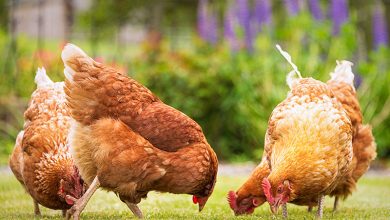Management of layer birds in rainy season – role of feed acidifier

Dr. Raju Jakkula,
MVSc, PhD (Animal Nutrition),
Nutrition & Health Solutions Manager,
DSM ANH, India
The India Meteorological Department has forecasted normal rainfall during the monsoon months of June-September 2021 in India. During the rainy season there will be an increase in relative humidity and a reduction in temperature; rainfall affects both the quantity and quality of feeding, while wind speed and direction have an influence on the outbreak of diseases. Sometimes heavy rainfalls or cyclones may happen in this season and cause problems to the poultry farmers. Poultry famers should be prepared well in advance to face the challenges that may arise in this rainy season.
Problems in rainy season:
• In rainy season, sometimes severe wind waves or cyclones may cause the interruptions in power supply in the poultry sheds and in feed plants.
• Cool weather in the poultry sheds due to continuous rainfall and cold waves along with interruptions in power supply may create serious brooding related problems for layer chicks.
• Stagnation of water in the surroundings of poultry farms may help in the growth of mosquitos and other insects. These insects will increase the chance of transmitting the diseases like fowl pox etc.
• Due to heavy rains or floods, falling of trees across the roads and disruption in the road transport system may happen leading to difficulties in the transport of feed, live birds, and eggs etc.
• Sometimes drinking water may get contaminated with rainwater resulting in the increase in bacterial infections like E. Coli and Salmonella etc.
• The high humidity in the atmosphere during the rainy season makes the poultry feed and feed raw materials wet.
• If the farmers are growing pullets in deep litter system, they need to take precautions to prevent wet litter condition. If the litter is wet, endo parasites like tapeworms and round worms will grow in the litter and enters the chickens. These endo parasites may slow down growth in chickens and cause several gut health issues. It is advisable to deworm the flock during the rainy season.
• High moisture content in the litter may increase the release of ammonia gas and predisposes the birds to respiratory diseases such as coryza and CRD.
• High humidity in the atmosphere, stagnated water in the farm and wet litter will increase the fly problems. Flies will spread coccidiosis, necrotic enteritis, and other bacterial and viral diseases.
• Wetting of finished feed or fed raw materials due to rain splash or accidental spillage of water may lead to the growth of molds and yeast in feed. These molds will produce harmful mycotoxins like aflatoxins etc.
• If the finished feed is stored for more than 30 days during this season, there will be increased chances of mycotoxin contamination and rancidity in the feed.
• During the monsoon season, there will be thick clouds in the sky and the daylight hours are less than 12 hours. If the artificial lighting in the farms is not adjusted accordingly, there will be reduced production of reproductive hormones like FSH and LH required for egg production in chickens.
• In this season there will be increased prevalence of coccidiosis, fowl pox, coryza, CRD, E. coli, salmonella, aspergillosis and mycotoxicosis.
Precautions to be taken during the rainy season:
• Any repairs on the roof, walls, and flooring of the poultry sheds / feed plants and godowns should be completed before the arrival of rainy season.
• In heavy rainfall regions, the floor should be raised with a generous roof overhang (4-5 feet from the wall), particularly over the entrance. This prevents rainwater from falling directly into the shed.
• The open sides of poultry sheds should be covered with polythene sheets. This prevents rainwater from falling directly into the shed and protects the chickens from severe cold waves.
• Prevent the water logging around the sheds to minimize the mosquitos and other insect problems
• To control the house flies regular spraying of insecticides is recommended. Use insecticides that will act both on the adult flies as well as larval stages. Electric fly repellent or pest control devices should be installed in the shed.
• Polythene curtains around the shed should be closed only when there is a rain or severe cold winds, otherwise ventilation related problems may happen. Lack of proper ventilation in poultry sheds can lead to an increase in the percentage of ammonia gas, stunted growth in chickens, ascites, and respiratory diseases.
Water management:
• Due to heavy rains, wastewaters from agriculture and urban areas, which might contain high levels of pathogenic microorganisms and other contaminants, are carried to the superficial and underground waters along with the rainwater.
• Chlorinate the water, using the most adequate method for your farm.
• Assess levels of residual chlorine daily. The presence of residual chlorine in the water pipes at an adequate concentration (2-5 ppm) assures the absence of microorganisms pathogenic to the birds.
• Regular use of good quality sanitizer in water can inactivate the harmful bacteria in the water.
• Water consumption is generally low during monsoon. Chickens should always be provided with clean water and water storage tanks should be cleaned frequently.
Lighting management:
• Daylight hours are short during the rainy season, providing adequate artificial light will help to maintain the optimum feed intake and egg production
• The laying hen needs 16 hours of lighting per day. In addition to the 12 hours of natural day light, artificial lighting should be provided in the morning or evening or at both times.
• In addition to the light duration, light intensity also affects the productivity of laying hens. The light intensity should be 20-40 watts.
Health management:
Coccidiosis:
• The causative agent for this disease is a protozoan parasite of the genus Eimeria.
• Typical symptoms of this disease include bloody diarrhea, stunted growth, dehydration, anemia, listlessness, ruffled feathers, death, and drop in egg production.
• Coccidiosis can be prevented by adding coccidiostats in the feed, as the chances of coccidiosis are high during the monsoon season.
Necrotic Enteritis
• The disease is caused by the bacterial toxins of Clostridium perfringens
• Chickens infected with coccidiosis are more likely to develop the disease.
E. coli:
• E. coli is transmitted to chickens due to use of contaminated water during monsoon.
• This problem can be avoided by cleaning the water tanks frequently, adding acidifier to the feed and sanitizers to the water.
Coryza / CRD:
• Bacterial diseases such as Coryza / CRD are also more common during the rainy season. In addition, the use of contaminated water can exacerbate the problem.
Mycotoxicosis
• Accidental wetting of feed raw materials or finished feeds in the godowns, during transport or due to rain splashes in the feeders and storage of feeds for longer duration may result in mold growth and mycotoxin production.
• The problem of toxins is very high during the rainy season due to high moisture content in the atmosphere.
• Consumption of mycotoxin contaminated feed by the poultry will cause liver damage, lameness, decreased egg production & egg weight, reduced feed efficiency, reduced antibody titers to vaccines. If the problem persists for long time, there will be mortality also.
• To prevent this problem, care should be taken to use quality raw materials in feed preparation and storage.
• Adding high quality mycotoxin deactivators and acidifiers in the feed will help in reducing the mycotoxin problems.
Feeding management:
• During the monsoon season there will be high humidity in the atmosphere, and the floor in the feed plant/godown is also likely to be moist. Hence, the feed raw materials should be placed on a high place like wooden tables instead of being placed directly on the ground.
• Feed bags and other feed raw materials should be kept 1-2 feet away from the wall in feed plants.
• Due to the possible disruption of road transport system due to heavy rains or floods, it is always advisable to store adequate feed for 4-5 days.
• In case of rainwater in the feed trough, the feed should be removed, and feeders should be cleaned thoroughly
• Do not store feed for more than 30 days during monsoon. This may lead to fungal growth and the formation of mycotoxins.
• Quality acidifier should be used in the feed to prevent the growth of fungus / mycotoxins in the feed due to high humidity in the atmosphere.
Use of feed acidifier in poultry diets:
Organic acids like benzoic, formic, propionic, and butyric acids etc. are commonly used in poultry diets as feed acidifiers. The supplementation of organic acids at the right doses in animal feed can increase the weight gain in pullets, improves feed conversion ratio, and reduces colonization of pathogens in the intestine. Almost all the organic acids used in animal nutrition, have an aliphatic structure, and represent a source of energy for the cells. Benzoic acid, instead, is built on an aromatic ring and has different metabolic and absorption characteristics.
Using feed acidifier will have following benefits
• Inhibition of gram-negative microflora in the gastro-intestinal tract
• Reduced pH, buffering capacity as well as antibacterial and antifungal effects in feed
• Improved protein digestibility & mineral bio availability
• Reduced subclinical diseases and general mortality in chickens
• Reduces wet droppings and cracked/ dirty eggs problems
Organic acids with a high pKa value are weaker acids and therefore more effective preservatives for feed. A strong acid (with low pKa) will acidify the feed and the stomach but will not have strong direct effects on the microflora in the intestine. If we use salt forms of organic acids considerably higher dosages are needed in feed to get measurable effects on animal performance. The bactericidal effect of the organic acids is: benzoic acid > fumaric acid > lactic acid > butyric acid > formic acid > propionic acid. Benzoic acid is superior to other acids in exhibiting bactericidal effect on coliforms and other harmful bacteria in both stomach and small intestine.
Advantages of using Benzoic acid
• It is a long-established preservative in the feed industry and particularly effective against fungi and yeasts.
• Inhibits the growth of Aspergillus flavus, reduces the spore count and mycotoxin production. It blocks an enzymatic step in the biosynthetic pathway of mycotoxins.
• Better feed preservation can help improve intake and performance.
• Helps in reducing the number of many pathogenic bacteria like Campylobacter jejuni, Escherichia coli, Listeria monocytogenes, and Salmonella enterica etc.
• Moderates the gut microflora, thereby reducing dysbiosis and improving digestion.
• Reduce ammonia production providing better environment for the chickens and the farm personnel
• By including pure Benzoic acid (Vevovitall) in poultry diets in this rainy season, producers can: improve the growth rate in pullets, enhance egg production & feed efficiency, reduced dirty eggs, or cracked egg problems and general mortality in layers.

Note: References available on request



